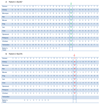Two Novel CAPN5 Variants Associated with Mild and Severe Autosomal Dominant Neovascular Inflammatory Vitreoretinopathy Phenotypes
- PMID: 29040051
- PMCID: PMC6711405
- DOI: 10.1080/09273948.2017.1370651
Two Novel CAPN5 Variants Associated with Mild and Severe Autosomal Dominant Neovascular Inflammatory Vitreoretinopathy Phenotypes
Abstract
Purpose: We report two new CAPN5 mutations associated with a phenotype of Autosomal Dominant Neovascular Inflammatory Vitreoretinopathy. Methods: We performed next generation sequencing in two patients with ADNIV phenotype; the variants identified were explored further. Results: Patient 1 was heterozygous for CAPN5 c.799G>A, p.(Gly267Ser). Patient 2 was heterozygous for CAPN5 c.1126G>A, p.(Gly376Ser). Both amino acids are highly conserved across species. Patient 1 had a severe phenotype and his mutation lies within the protein's catalytic domain. Patient 2 had a mild phenotype and her mutation is the first ADNIV-causing mutation to be described in the regulatory domain of Calpain-5. Conclusions: Our findings potentially add two new ADNIV-causing CAPN5 mutations to the three previously described. We recommend CAPN5 genetic testing in all patients with a possible ADNIV phenotype, to develop our understanding of Calpain-5; a protein which could potentially provide therapeutically accessible targets for the treatment of many leading causes of blindness.
Keywords: ADNIV; Autosomal Dominant Neovascular Inflammatory Vitreoretinopathy; CALPAIN-5; CAPN5; UVEITIS.
Conflict of interest statement
The authors report no conflicts of interest. The authors alone are responsible for the content and writing of the paper.
Figures




Similar articles
-
Structural modeling of a novel CAPN5 mutation that causes uveitis and neovascular retinal detachment.PLoS One. 2015 Apr 9;10(4):e0122352. doi: 10.1371/journal.pone.0122352. eCollection 2015. PLoS One. 2015. PMID: 25856303 Free PMC article.
-
Early Onset Neovascular Inflammatory Vitreoretinopathy Due to a De Novo CAPN5 Mutation: Report of a Case.Ocul Immunol Inflamm. 2019;27(5):706-708. doi: 10.1080/09273948.2019.1582783. Epub 2019 Apr 15. Ocul Immunol Inflamm. 2019. PMID: 30986125 Free PMC article.
-
Functional validation of a human CAPN5 exome variant by lentiviral transduction into mouse retina.Hum Mol Genet. 2014 May 15;23(10):2665-77. doi: 10.1093/hmg/ddt661. Epub 2013 Dec 30. Hum Mol Genet. 2014. PMID: 24381307 Free PMC article.
-
Autosomal dominant neovascular inflammatory vitreoretinopathy with CAPN5 c.731T > C gene mutation; clinical management of a family cohort and review of the literature.Ophthalmic Genet. 2023 Dec;44(6):559-567. doi: 10.1080/13816810.2023.2255257. Epub 2023 Nov 20. Ophthalmic Genet. 2023. PMID: 37782277 Review.
-
Familial exudative vitreoretinopathy and related retinopathies.Eye (Lond). 2015 Jan;29(1):1-14. doi: 10.1038/eye.2014.70. Epub 2014 Oct 17. Eye (Lond). 2015. PMID: 25323851 Free PMC article. Review.
Cited by
-
Association of Clinical and Genetic Heterogeneity With BEST1 Sequence Variations.JAMA Ophthalmol. 2020 May 1;138(5):544-551. doi: 10.1001/jamaophthalmol.2020.0666. JAMA Ophthalmol. 2020. PMID: 32239196 Free PMC article.
-
The Identification of Proteolytic Substrates of Calpain-5 with N-Terminomics.Int J Mol Sci. 2025 Jul 4;26(13):6459. doi: 10.3390/ijms26136459. Int J Mol Sci. 2025. PMID: 40650235 Free PMC article.
-
CAPN5 genetic inactivation phenotype supports therapeutic inhibition trials.Hum Mutat. 2019 Dec;40(12):2377-2392. doi: 10.1002/humu.23894. Epub 2019 Aug 26. Hum Mutat. 2019. PMID: 31403230 Free PMC article.
-
A novel de novo CAPN5 mutation in a patient with inflammatory vitreoretinopathy, hearing loss, and developmental delay.Cold Spring Harb Mol Case Stud. 2018 Jun 1;4(3):a002519. doi: 10.1101/mcs.a002519. Print 2018 Jun. Cold Spring Harb Mol Case Stud. 2018. PMID: 29472286 Free PMC article.
-
Capn5 Expression in the Healthy and Regenerating Zebrafish Retina.Invest Ophthalmol Vis Sci. 2018 Jul 2;59(8):3643-3654. doi: 10.1167/iovs.18-24278. Invest Ophthalmol Vis Sci. 2018. PMID: 30029251 Free PMC article.
References
-
- Kirschner R, Rosenberg T, Schultz-Heienbrok R, et al. RPGR transcription studies in mouse and human tissues reveal a retina-specific isoform that is disrupted in a patient with X-linked retinitis pigmentosa. Hum Mol Genet. 1999;8(8):1571–1578. - PubMed
Publication types
MeSH terms
Substances
Grants and funding
LinkOut - more resources
Full Text Sources
Other Literature Sources
